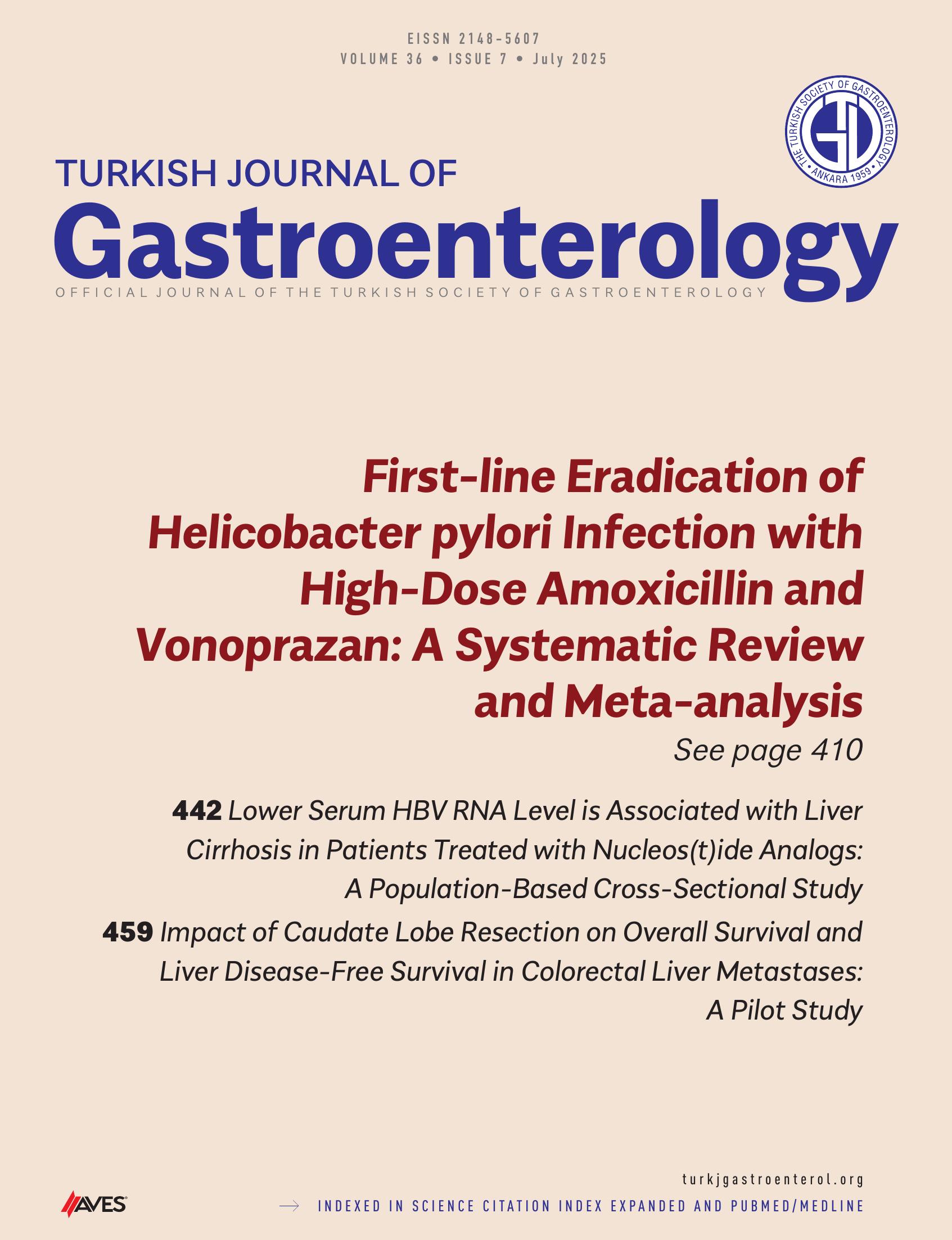Lower Serum HBV RNA Level is Associated with Liver Cirrhosis in Patients Treated with Nucleos(t)ide Analogs: A Population-Based Cross-Sectional Study
Main Article Content
Abstract
Background/Aims: There is evidence suggesting an association between hepatitis B virus (HBV) RNA and hepatic fibrosis in treatmentnaïve chronic hepatitis B (CHB) patients. However, few studies have delved into the relevance between HBV RNA and HBV-related cirrhosis. The purpose of this article is to elucidate the connection between HBV RNA and cirrhosis in patients undergoing nucleos(t)ide analogs (NAs).
Materials and Methods: This study included 381 patients. Logistic regression was employed to investigate the variables linked to the development of cirrhosis. Propensity score matching was used to correct for confounders.
Results: In this cross-sectional study, multivariable logistic regression showed HBV RNA detectability was associated with cirrhosis. Multivariate regression suggests that the variables associated with cirrhosis were: older age, HBV RNA above the lower limit of quantification, shorter duration of treatment, higher level of serum bilirubin, and treatment strategy. Among patients with quantifiable HBV RNA (n = 242), cirrhotic patients exhibit lower median serum HBV RNA titers compared to those with CHB patients. Furthermore, qHBsAg ≤ 3.3 lg IU/mL and qHBV RNA ≤ 3.7 lg copies/mL may be linked to cirrhosis.
Conclusion: Nucleos(t)ide analogs treatment may result in varying degrees of decrease in HBV RNA levels. Lower levels of HBV RNA may be linked to the development of cirrhosis.
Cite this article as: Wu J, Zhang Y, Gao H, et al. Lower serum HBV RNA level is associated with liver cirrhosis in patients treated with nucleos(t)ide analogs: A population-based cross-sectional study. Turk J Gastroenterol. Published online March 18, 2025. doi 10.5152/ tjg.2025.24648.
Article Details
References
1. Collaborators PO. Global prevalence, treatment, and prevention of hepatitis B virus infection in 2016: a modelling study. Lancet Gastroenterol Hepatol. 2018;3(6):383-403.
2. Terrault NA, Lok ASF, McMahon BJ, et al. Update on prevention, diagnosis, and treatment of chronic hepatitis B: AASLD 2018 hepatitis B guidance. Hepatology. 2018;67(4):1560-1599. [CrossRef]
3. Mak LY, Cloherty G, Wong DKH, et al. HBV RNA profiles in patients with chronic hepatitis B under different disease phases and antiviral therapy. Hepatology. 2021;73(6):2167-2179. [CrossRef]
4. Carey I, Gersch J, Wang B, et al. Pregenomic HBV RNA and hepatitis B core-related antigen predict outcomes in hepatitis B e antigen-negative chronic hepatitis B patients suppressed on Nucleos(T)ide analogue therapy. Hepatology. 2020;72(1):42-57. [CrossRef]
5. Luo H, Tan N, Kang Q, et al. Hepatitis B virus pregenomic RNA status can reveal the long-term prognoses of chronic hepatitis B patients treated with nucleos(t)ide analogues. J Viral Hepat. 2020;27(3):323-328. [CrossRef]
6. Mak LY, Wong D, Kuchta A, et al. Hepatitis B virus pre-genomic RNA and hepatitis B core-related antigen reductions at week 4 predict favourable hepatitis B surface antigen response upon long-term nucleos(t)ide analogue in chronic hepatitis B. Clin Mol Hepatol. 2023;29(1):146-162. [CrossRef]
7. Xia M, Chi H, Wu Y, et al. Serum hepatitis B virus RNA level is associated with biochemical relapse in patients with chronic hepatitis B infection who discontinue nucleos(t)ide analogue treatment. Aliment Pharmacol Ther. 2021;54(5):709-714. [CrossRef]
8. Liu S, Deng R, Zhou B, et al. Association of serum hepatitis B Virus RNA with hepatocellular carcinoma risk in chronic hepatitis B patients under Nucleos(t)ide analogues therapy. J Infect Dis. 2022;226(5):881-890. [CrossRef]
9. Huang C, Li Q, Xu W, et al. Serum HBV RNA levels predict significant liver fibrosis in patients with chronic HBV infection. Discov Med. 2020;29(157):119-128.
10. Liu Y, Jiang M, Xue J, Yan H, Liang X. Serum HBV RNA quantification: useful for monitoring natural history of chronic hepatitis B infection. BMC Gastroenterol. 2019;19(1):53. [CrossRef]
11. Deng R, Liu S, Shen S, Guo H, Sun J. Circulating HBV RNA: from biology to clinical applications. Hepatology. 2022;76(5):1520-1530. [CrossRef]
12. Iannacone M, Guidotti LG. Immunobiology and pathogenesis of hepatitis B virus infection. Nat Rev Immunol. 2022;22(1):19-32. [CrossRef]
13. Marchetti AL, Guo H. New insights on molecular mechanism of hepatitis B virus covalently closed circular DNA formation. Cells. 2020;9(11):2430. [CrossRef]
14. Liu S, Liu Z, Li W, et al. Factors associated with the biphasic kinetics of serum HBV RNA in patients with HBeAg-positive chronic hepatitis B treated with nucleos(t)ide analogues. Aliment Pharmacol Ther. 2020;52(4):692-700. [CrossRef]
15. Sonneveld MJ, Hansen BE, Brouwer WP, et al. Hepatitis B surface antigen levels can be used to rule out cirrhosis in hepatitis B e antigen-positive chronic hepatitis B: results from the SONIC-B study. J Infect Dis. 2022;225(11):1967-1973. [CrossRef]
16. Shi Q, Yu R, Sun Q, Wang C, Yao J, Zhang L. The relationship between collagen proportionate area and hepatitis B surface antigen levels in E antigen positive hepatitis B cirrhosis. Turk J Gastroenterol. 2022;33(1):62-67. [CrossRef]
17. Bian D, Zhao J, Liao H, et al. Serum HBV RNA is associated with liver fibrosis regression in HBeAg-positive chronic hepatitis B patients treated with nucleos(t)ide analogues. J Viral Hepat. 2023;30(4):303-309. [CrossRef]
18. Sun Y, Wu X, Zhou J, et al. Persistent low level of hepatitis B virus promotes fibrosis progression during therapy. Clin Gastroenterol Hepatol. 2020;18(11):2582-2591.e
19. Chang X, Li Y, Sun C, et al. High-risk population of progressive hepatic fibrosis in chronic hepatitis B patients on antiviral therapy. J Gastroenterol. 2023;58(5):481-493. [CrossRef]
20. European Association for the Study of the Liver. Clinical Practice Guideline Panel, Chair:;EASL Governing Board representative:;Panel members:. EASL Clinical Practice Guidelines on non-invasive tests for evaluation of liver disease severity and prognosis - 2021 update. J Hepatol. 2021;75(3):659-689. [CrossRef]
21. Liu Y, Zhu P, Wang W, et al. Mucosal-associated invariant T cell dysregulation correlates with conjugated bilirubin level in chronic HBV infection. Hepatology. 2021;73(5):1671-1687. [CrossRef]
22. Yip TCF, Wong VWS, Chan HLY, Tse YK, Lui GCY, Wong GLH. Tenofovir is associated with lower risk of hepatocellular carcinoma than entecavir in patients with chronic HBV infection in China. Gastroenterology. 2020;158(1):215-225.e6. [CrossRef]


